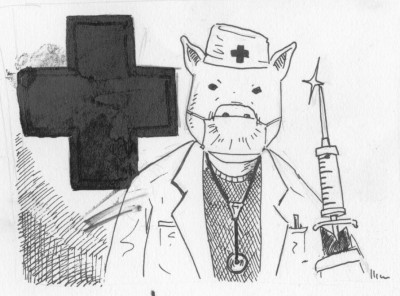Suzanne Kleine ’11 and Kelsey Landauer ‘12
Features Editor and Staff Writer
The novel H1N1 influenza, commonly known as “swine flu” is expected to return on a larger scale this coming year.
The disease has been growing since its outbreak last year. From April 15, 2009 to July 24, 2009, states reported a total of 43,771 confirmed and probable cases of H1N1, according to the Center for Disease Control, the CDC.
Staples parent Louise McGlynn’s perspective on the swine flue craze is that it was definitely an over reaction. “It’s not like the plague,” said McGlynn, “I think that the parents are just caught up in the panic. The concern and all that stuff is appropriate,” but McGlynn feels that people should reconsider the severity of the pandemic. Parents like McGlynn simply expect everyone to make an effort in avoiding the sickness.
All schools have been informed and advised about the appropriate precautions to take once the swine flu has begun to spread within a school. The primary form of protection that each student and their families can take is the H1N1 vaccine, which will become available in mid-October. Doctors were anticipating a vaccine that required two doses in order to be effective, but as of September 15 the FDA approved a one dose vaccine.
According to Dr. Peter Czuczka of Willows Pediatric, “the safety of the vaccine is very good.” Since there will be limited amounts of the vaccine available, the CDC advises pregnant women, health care workers, and people six months to 24 years should be vaccinated first.
The Staples High School nurses, Alicia Casucci and Susie Miller, strongly support students getting vaccinated. However, the seasonal flu shot will “provide some kind of protection” against H1N1.
Tom Karrel ‘12, a supporter of the swine flu vaccine, feels that people did not over react to swine “because unlike most sicknesses, it is spreading rapidly and it’s right for people to be cautious.” However, Jen Abrams, ’11 remains unworried about the spread of swine. “It’s just like any other form of the flu,” she says. “People are just getting worried because it’s new and they don’t know much about it.”
While the vaccines are capable of protecting against the swine flu’s current form, if the virus mutates the vaccine will become ineffective. The virus has not mutated yet, “and that is very, very good,” says Czuczka.
Especially since the two diseases are so similar, it can be hard to tell if the flu is just a flu, or if it’s H1N1. Casucci advises all students staying home sick with the flu, or if flu symptoms exist, to call their physicians early on. Casucci added that swine is virulent, and that it is very easy to catch and spread. Although the H1N1 virus is easy to catch, the symptoms are not comparatively worse than the regular seasonal flu.
If a member of your family has the H1N1 virus, be careful not to catch the virus. Secondary attack rates, meaning the chance of getting infected from another family member, or a person living in your house, are about 8-12%.
The virus can stay alive for “2-8 hours on a desk,” says Casucci, so washing hands often is the best way to protect oneself from the swine flu. “Keep your hands out of your mouth, nose, and eyes. Get enough sleep, exercise, and eat healthy,” says Casucci about preventing the flu.
“There are no plans for a swine flu-cation,” says Miller.












































